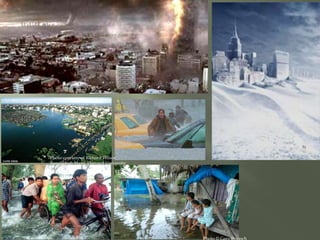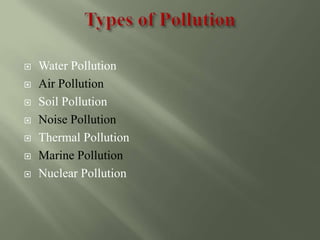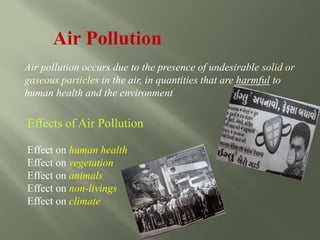Earth as a living planet
- 1. Humans have brought Earth to brink of biotic crisis ENVIRONMENTAL ISSUES GLOBAL, NATIONALAND STATE LEVEL SOCIO-ECONOMIC & CALTURAL IMPECT THROUGH THESE ISSUES -DR.ANILKUMAR PANDYA For us only planet to live is the Earth
- 2. EARTH AS A LIVING PLANET
- 4. Slide 4 The environment encompasses the whole of life on earth and the complex interactions that link the living world with the physical world In a general sense, this covers everything contained within the air, land and water Time also is a key factor as historic issues have an influence on the status of the environment - locally and globally, both now and in the future. Natural, Man-made & Social environment .
- 5. Functional unit : a.) Biotic (producers & consumers) b.) Abiotic (climate & Inorganic salts ) a.) Biotic : 1) Autotrophic 2) Heterotrophic
- 8. Change in any component causes discomfort to all & affect normal life
- 10. End Ordovician (~445 Ma) Late Devonian (~365 Ma) End Permian (~250 Ma) End Triassic (~210 Ma) End Cretaceous (65 Ma) And we are moving towards the SIXTH……
- 12. Emergence of discontinuities in organism’s preferred environment. Fragmentation and destruction of Great Ape habitat in Central Africa.
- 13. The 11 Marine Hotspots
- 15. Slide 15 Sudden and dramatic natural changes to the environment have occurred in the distant past, but only relatively recently has one species had the potential to upset the whole balance of the Earth's ecosystem The global population growth The rise of industry and its rapid expansion has been a major source of pollution. This has caused changes in the balance of our environment
- 16. Slide 16 From http://www.pref.kyoto.jp/intro/21cent/kankyo/contents_e/globe_prob/index.html Global Warming Ozone Layer Depletion Acid Rain Deforestation Loss of Biodiversity Pollution Desertification Waste disposal
- 17. Slide 17 • Human activities are increasing the amount of greenhouse gases in the atmosphere, which cause more heat to be trapped • Predicted effects of global warming include: – Higher sea levels – Higher temperatures – Variable climatic conditions – These changes are expected to cause a significant impact on agriculture and ecosystems. Greenhouse gases help to maintain the earth’s temperature at a level suitable to support life
- 19. Photo © Gary Braasch Photo courtesy of Richard Wilson, Bangladesh Maps, Harvard University
- 20. Slide 20 The ozone layer protects the earth from harmful ultraviolet (UV) light The use of chlorofluorocarbons (CFCs) and other ozone depleting substances as refrigerants, solvents and insulation is destroying the ozone layer A ‘hole’ is observed over Antarctica every autumn Depleted ozone levels cause the following impacts: Increased penetration of UV light to earth Increased risks of skin cancer and eye diseases Damage to agricultural crops Disruption to marine food chains Ozone layer thickness measured in Dobson Units Animation sourced from:
- 21. Prepared June 2004 Slide 21 The burning of fossil fuels leads to atmospheric emissions of NO2 and SO2 These gases react with water and oxygen to make sulfuric and nitric acids. Sunlight increases the rate of these reactions Rain, snow and fog can be polluted with these acidic compounds, which is then deposited at the earths surface The deposition of acids can: Damage forests and soils Causes acidification of lakes and other water bodies Disturb wildlife Cause the decay of building and other structures Impact on human health
- 22. Slide 22 The deforestation of tropical rainforests is a major global problem- each year millions of hectares are lost Deforestation rates in some countries continue to increase despite worldwide pressures Rainforests are destroyed for wood products, and to make way for agricultural activities, mining and dams. The impacts of deforestation include: Loss of livelihood for local inhabitants Variable environmental conditions (susceptibility to flood, aggravated droughts, soil erosion etc) Loss of biodiversity and disturbance to ecosystems Loss of carbon sink
- 24. ABOUT 22 HECTARES OF FORESTLAND ARE CUT DOWN EVERY MINUTE ALL OVER THE WORLD.
- 25. Slide 25 Biodiversity has three key components: Genetic diversity Species diversity Ecological diversity Approximately 2.1 million species are known to exist, but up to 50 million still to be discovered Biodiversity is important for food, drugs, maintaining ecological stability, aesthetic and cultural benefits Natural causes and human activity can threaten biodiversity The loss of biodiversity means ecosystems are destabilized, vital resources are lost and genetic variation is reduced
- 26. Water Pollution Air Pollution Soil Pollution Noise Pollution Thermal Pollution Marine Pollution Nuclear Pollution
- 27. Slide 27 A change in water quality that impacts on living organisms Types and effects of water pollution include: Infectious agents, such as typhoid, cholera Nutrients and eutrophication Toxic materials, through mining Organic chemicals Sediments can disrupt aquatic ecosystems
- 28. Caused through sewage and other wastes Caused through industrial discharges Caused through agricultural discharges Caused through solid waste of industries Measure to control water pollution Disinfection of water Sedimentation Filtration Softening of water Each liter of wastewater pollutes at least eight liter of freshwater
- 29. Air Pollution Air pollution occurs due to the presence of undesirable solid or gaseous particles in the air, in quantities that are harmful to human health and the environment Effects of Air Pollution Effect on human health Effect on vegetation Effect on animals Effect on non-livings Effect on climate
- 31. Controlling pollution at the source Construction of tall chimneys Development of green belt around industrial areas Use of better quality fuel and use of catalytic converters Sprinkling water in mining areas to reduce the dust particles Air quality monitoring
- 32. It is the contamination caused by chemicals and other subsistence's resulting in the loss of the fertility of the production of soil. Causes of Soil Degradation Humans, Insecticides, Industrial wastes, Radioactive waste, Nitrification Methods of controlling the soil degradation 1. By making vegetation cover 2. By terrace or contour bonding 3. By controlling the grazing 4. By applying water infiltration measures for soil and moisture conservation
- 33. A sound of unpleasant and annoying nature • Greater than 140 dB causes noise pollution • Normal talk 40 dB shouting is 60 dB • Big auto machines 90 dB • Traffic 70 dB • Lightening 120 dB • Airplanes 150 dB • Rocket engines 190 dB
- 34. Slide 34 Removing ground cover and degrading fertile land initiates desertification Water washes away nutrients, the land becomes inhospitable The process is accelerated by expanding populations and the need to overuse fragile areas of land
- 35. Slide 35 Waste disposal methods include: Open dumping and landfill Ocean dumping Exporting waste Waste to energy plants Minimizing the waste stream: 3R’s: reduce, reuse, recycle Composting Waste to energy Hazardous waste disposal Needs to be safely handled and disposed of to minimize threats to the environment and human health
- 37. 1. Loss/degradation of habitat 2. Overexploitation of resources 3. Pollution 4. Extinction of species due to aggressive non-native species 5. Global environmental changes
- 38. Floods, Earthquakes, Cyclones, Landslides, Droughts, Tsunami Public awareness training Institutional mechanisms Incentives &resources for mitigation Land use planning & regulation Hazard resistant design &construction Structural and constructional reinforcement of existing buildings Dams, Reservoirs, Maintaining Wetland Early warning system Public Health System
- 40. From Unsustainable to Sustainable development Urban problems related to energy (energy efficiency) Water conservation, rain water harvesting Resettlement & Rehabilitation of people
- 41. Environmental ethics: Resource consumption pattern & the need for equitable utilization: Urban-Rural; Rich-Poor; Religious faith; man-Woman; Professional- Non-Professional; Educated-Uneducated; Sense of use-overuse-misuse by individual, especially between Eastern Western countries. Preserving resources for future generation. Ethical basis of environment education & awareness. -The gandhian way of life. -Education in nature-:Shantiniketan model
- 42. Hindu-God & Goddess. Animals as `VAHAN’. Plants &Flowers as symbols: ( Ficus, Tulsi, Bilipatra, Lotus etc.) Way of conserving nature and living sustainable life style.
- 43. The Solutions are Simple
- 45. CARBON FOOTPRINT Ecological Footprint (EF)
- 46. 46 IS A MEASURE OF THE ‘LOAD’ IMPOSED BY A GIVEN POPULATION ON NATURE. IT REPRESENTS THE LAND AREA NECESSARY TO SUSTAIN CURRENT LEVELS OF RESOURSES CONSUMPTION AND WASTE DISCHARGE BY THAT POPULATION.
- 47. INDIA 0.4 HECTARE WORLD 1.8 HECTARES UNITED STATE 5.4 HECTARES CHILDREN BORN IN CHILDREN BORN IN 1.8 HECTARES X 10 BILLION =18 BILLION HECTARES
- 48. 1.8 hectares of productive land is available for each person. But every human uses 2.3 hectares Today humanity’s eco-footprint is 40 % larger than what the planet can regenerate. That is, it take about a year and five month (17 months) for earth to regrow what we use in a single year. To save the environment and ensure socio-equity, rich nations need to cut down consumption by 90 per cent
- 49. This is one of indicator of sustainability This is widely used now a day in all forums The Ecological Footprint is usually measured in global hectares. Because trade is global, an individual or country's Footprint includes land or sea from all over in the world. Ecological Footprint is often referred to in short form as Footprint (not footprint).
- 50. 1900 21002002 2050 If we all keep / adopt the western patterns of production & consumption
- 52. It is vital that we instigate change in order to improve living standards of all and reduce the impact on planet. Choices that we make now will shape our opportunities in future and those of future generations. But availability of alternative models and vision for sustainable future is not enough, what we need is ‘action’.
- 54. Decrease your Footprint Increase your Handprint Handprint is a new tool being developed by Centre for Environment Education (CEE), India to help measure action at different levels. One needs to ask what one does at individual, community, national and global level.
- 56. The Concept of Sustainable Development “Taking care of the needs of the present generation without compromising on the capabilities of future generation.” World Commission on Environment and Development, 1987
- 58. THANKS

























































